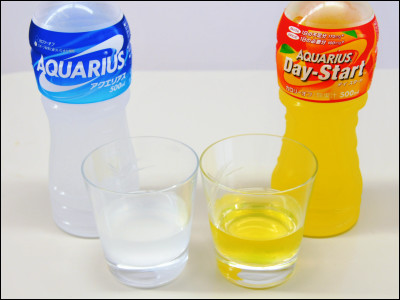How is caffeine manufactured and what are its effects and problems?
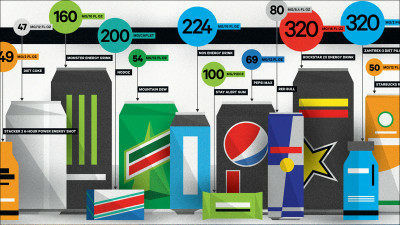
Many people take caffeine for various reasons, such as to concentrate on their work and to wake up from sleepiness.
Inside the Overstimulated, Underregulated Caffeine Industry | Wired Science | Wired.com
http://www.wired.com/wiredscience/2013/01/ff-caffeine/
◆ Caffeine content of each product
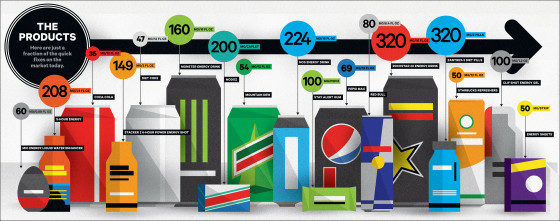
First of all, how much caffeine is contained in each energy drink is arranged in descending order of content. For reference, tablets are also described.
320mg (approx. 470ml):
320mg (2 tablets): Zantrex3
224mg (approx. 470ml): NOS Energy Drink
208mg (about 56ml): 5-hour ENERGY
200mg (1 tablet): NoDoz
160mg (approx. 470ml) Monster Energy Drink
149mg (approx. 60ml): Stacker2 6 Hour Power
100mg (approx. 35ml): CLIF SHOT Energy Gel
100mg (1 tablet): Stay Alert Gum
80mg (approx. 250ml): Red Bull Energy Drink
60mg (approx. 2.4ml): MiO Liquid Water Enhancer
69mg (approx. 350ml): PEPSI MX
54mg (about 350ml): Mountain Dew
50mg (approx. 350ml): Starbucks Refreshers
50mg (1 sheet): Energy Sheets
47mg (about 350ml): Diet Coke
35mg (approx. 350ml): Coca-Cola
◆ Synthetic caffeine manufacturing process
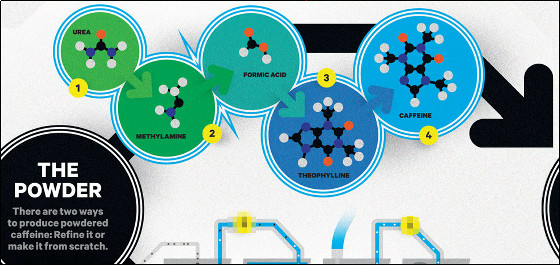
Synthetic caffeine is synthesized from urea (No. 1 in the image), which contains a large amount of nitrogen produced from ammonia. Urea is first converted to a drug such as methylamine and formic acid (No. 2), and then to theophylline with caffeine-like properties (No. 3). Finally, methylation of theophylline completes pure synthetic caffeine (No. 4).
Most of the caffeine is produced in China these days, and when you walk near the synthetic caffeine factory, it smells like cat pee.
◆ Manufacturing process of natural caffeine
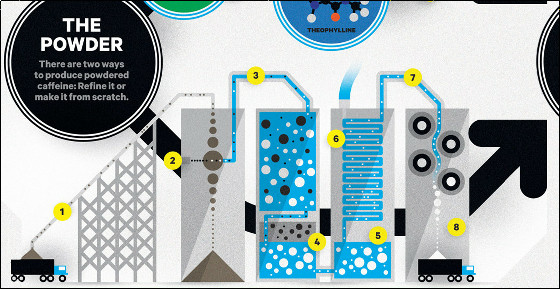
Natural caffeine is extracted from coffee beans. First, lift the beans to the top of the tower on the 16th floor and drop them from there (No. 1 in the image).
At this time, high-pressure carbon dioxide is used to remove caffeine from the falling beans without damaging the flavor of the coffee (No. 2) and mix with water (No. 3).
After mixing, carbon dioxide is separated when the pressure drops (No. 4), and caffeine water is stored in a tank (No. 5). At this point, the percentage of caffeine is about 0.2%. From here, the water is evaporated and concentrated like syrup (No. 6).
Pour the concentrated liquid into a rotating drum and let it dry (No. 7), leaving a flake-like powder at the end. This is natural caffeine with a purity of about 95%. The largest natural caffeine manufacturer in the United States is
◆ About the effects and problems of caffeine
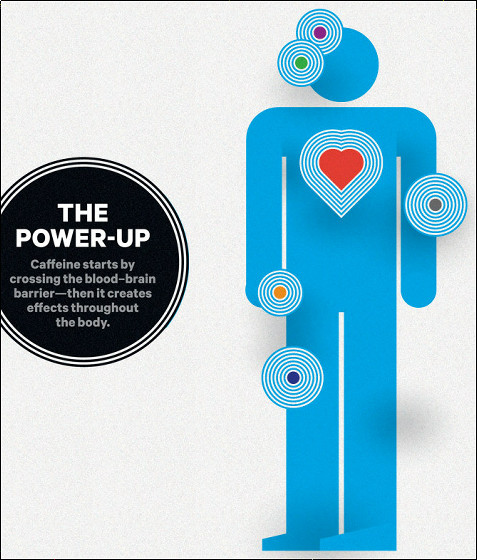
・ Effects of caffeine on the body
The effect of caffeine on the body looks like this when viewed by part.
Head: Caffeine blocks the receptors normally occupied by the neurotransmitter adenosine, which signals fatigue, resulting in energy and arousal. Caffeine also enhances memory.
Arms: A 2010 study found that caffeine has the effect of strengthening the upper body (results of a study of women attending the gym) and endurance (race time reduced by an average of 1% or more in a 2000-meter boat competition). I did.
Eyes: A study of Navy SEALs trainees found that 200 mg to 300 mg of caffeine improved alert and visual reaction times.
Hand: A 1912 study reported an increase in the speed of a 38-year-old female typewriter, but recent studies have shown that it impairs the performance of fine exercise.
Feet: Runners seem to get a lot of benefits from caffeine, for example, they can extend the time to the limit when they keep running. In general, athletes should take 3 to 6 mg of caffeine per kg of body weight to maximize the benefits of caffeine. A player weighing 80 kg needs to drink about 480 mg of caffeine, or 6 bottles in terms of Red Bull.
・ Problems with caffeine
Caffeine has a diuretic effect that causes addiction and dehydration, and overdose of caffeine can lead to death from cardiopulmonary arrest in the worst case. The U.S. Food and Drug Administration (FDA) does not publish much data on 13 deaths from caffeine, but at least three deaths were caused by a heart attack. Usually, lethal amounts of caffeine are considerable, and in the case of British Michael Bedford in April 2010, he swallowed two scoops of pure caffeine powder with an energy drink and then vomited. It is reported that he collapsed and died. In this case, you have ingested about 5g or more of caffeine (equivalent to drinking 24 cans of 5-hour ENERGY).
Related Posts:
in Note, Posted by darkhorse_log





